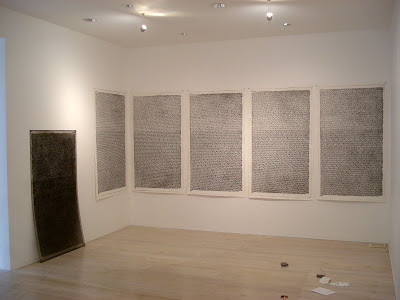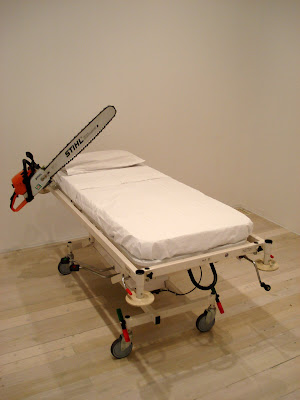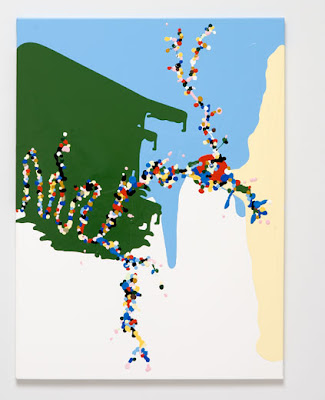They come in with requests. They want to use the photocopier for free. Some of them want blank paper to write down their filthy secrets. Most of ‘em just sleep in the reading room. Yes, it’s your local library and that long haired guy behind the counter, the bloke with the smile on his face ready to help you sort out the mysteries of quarto non-fiction, well, he’s itching to do you some harm. Or maybe do himself. Or both. It’s the local library murder suicide pact. Such is the fetid place from which What’s show Casual Library Assistant at Gallery 9 springs.
What’s work, as far as we can tell, has been about a very conscious and deliberate attempt at ordering experience of the world into categories of representation. The first show we saw were his big paintings in Wollongong of pixilated images from the web put together at immense scale. The next show, OK Commuter at Firstdraft, had the artist’s old SAAB parked in the gallery space inscribed with excerpts from the artist’s diary. The ‘space filler’ paintings came next where the artists emulated the look of abstract paintings by filling up old picture frames with white goo. Then there are other works we’ve seen, including lovely photos of clouds, a drawing of the background radiation of the universe, paintings made using syringes, a buried truck and a very impressive picture of What’s penis. No wonder the guy works in a library, he was born to order the world.

What’s Casual Library Assistant, Gallery 9, installation view.
But order breaks down as noise plagues the system. Although What has tried to get things together, his personal, emotional self gets in the way of the process and so we end up with the work in Casual Library Assistant. In one room is the Self Check Out Terminal, a hospital bed with a chainsaw attached at just the right position for auto-decapitation. On the facing wall a body is hung in silhouette with the words “New Years Resolution” on its chest. That one is the title piece. Another room has a body floating face down in a pool [dummy, blow up pool, a restriction-busting megalitre of water]. That’s called Ability To Communicate With Others. Are we happy yet? In the other two rooms a change of formal pace: a wall of drawings of library patrons varying in style from ersatz-brut to Euro-minimal, and the final room – a million lines attesting to the artist’s belief that death is the only option.

What, Self Check Out Terminal, 2007.
Various materials and dimensions.
Courtesy Gallery 9.
This is half of a great show. But which half? It depends on how you respond to the obvious. Normally, obvious is a synonym for bad, but a bluntly stated idea can be as effective as cutting your own head off to get attention. It tends to work but it’s very short lived. If you prefer your incipient insanity cut with a good dose of irony and humor, then What is also your man. His million lines of I-hate-myself-and-I-want-to-die scribbling was actually made with a crude print so not a lot of time was really spent there. It’s more of a special effect. And the drawings of the patrons – priced to sell – are gorgeous. We came away from the show impressed as hell but wanting What to drop the obvious stuff that plays well in an artist-run space and go for the aesthetic prize-winning cha cha cha that he can do so well. But then he’d probably be a very different kind of artist.

Huseyin Sami, Welcome to Tomorrow, 2007.
Acrylic on canvas, 101x76cms.
Courtesy of Sarah Cottier Gallery
The artist Huseyin Sami has very impressive hair. He is pictured on the cover of the publication that accompanies his latest show at Sarah Cottier Gallery getting a trim. He looks both surprised and disgruntled. Sami is part of a group of artists who we have decided to call Eccentric Systemists that would include all those artists who put some sort of system on top of their creative endeavours but can’t resist messing with it at the last moment. Early works by Sami were elaborate painting machines, stacked layers of perforated plastic or boards, held in a frame, through which paint dripped down on to plastic sheets. In other works, he stretched and warped paint in as many ways possible – brightly coloured cocoons, web-like strings, turd like lumps, stretchers hung from balloons. Where could paint go next?
Sweet Days Wilderness finds Sami back again with a few of the previous methods of ‘painting’ returning [lumps, piles, strings, festive trees] but with a brave new step in an unexpected direction – to the canvas. The detritus of his previous painting experiments has been a collection of dried films of acrylic paint that, since they’re plastic, can be peeled off the floor and stuck on to other surfaces. And so, the dozen or so canvases in Sweet Days Wilderness, are constructed rather than painted, painstakingly glued together while giving the impression they are the result of an incredible series of happy accidents. The paintings look like a three way tussle between Miro, Hans Arp and Takashi Murakami, lots of weird creatures lost in a hyper colourful landscape. The similarity is only superficial, however, as we suspect Sami is on a much more serious trip breaking down the barriers of painting, indeed, heading off into the expanded field like many of other illustrious alumni of Sydney College of the Arts. What a joy he’s doing it with a sense of humour too.
